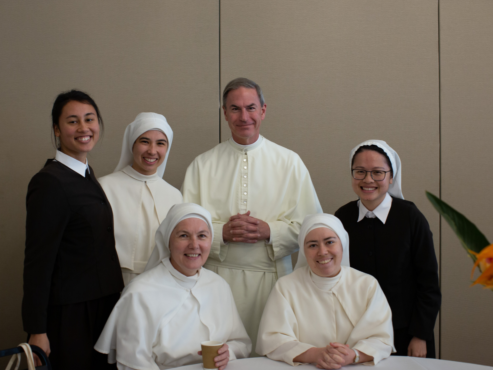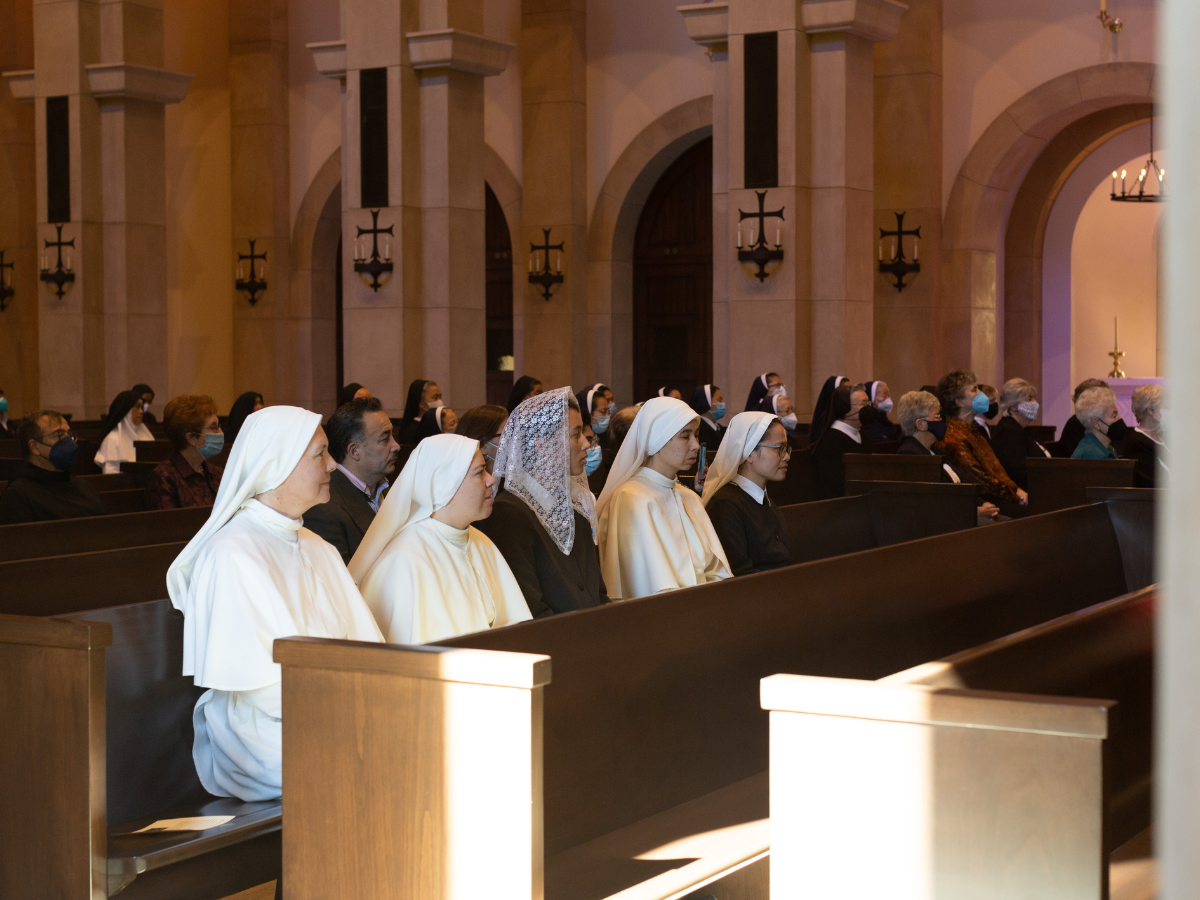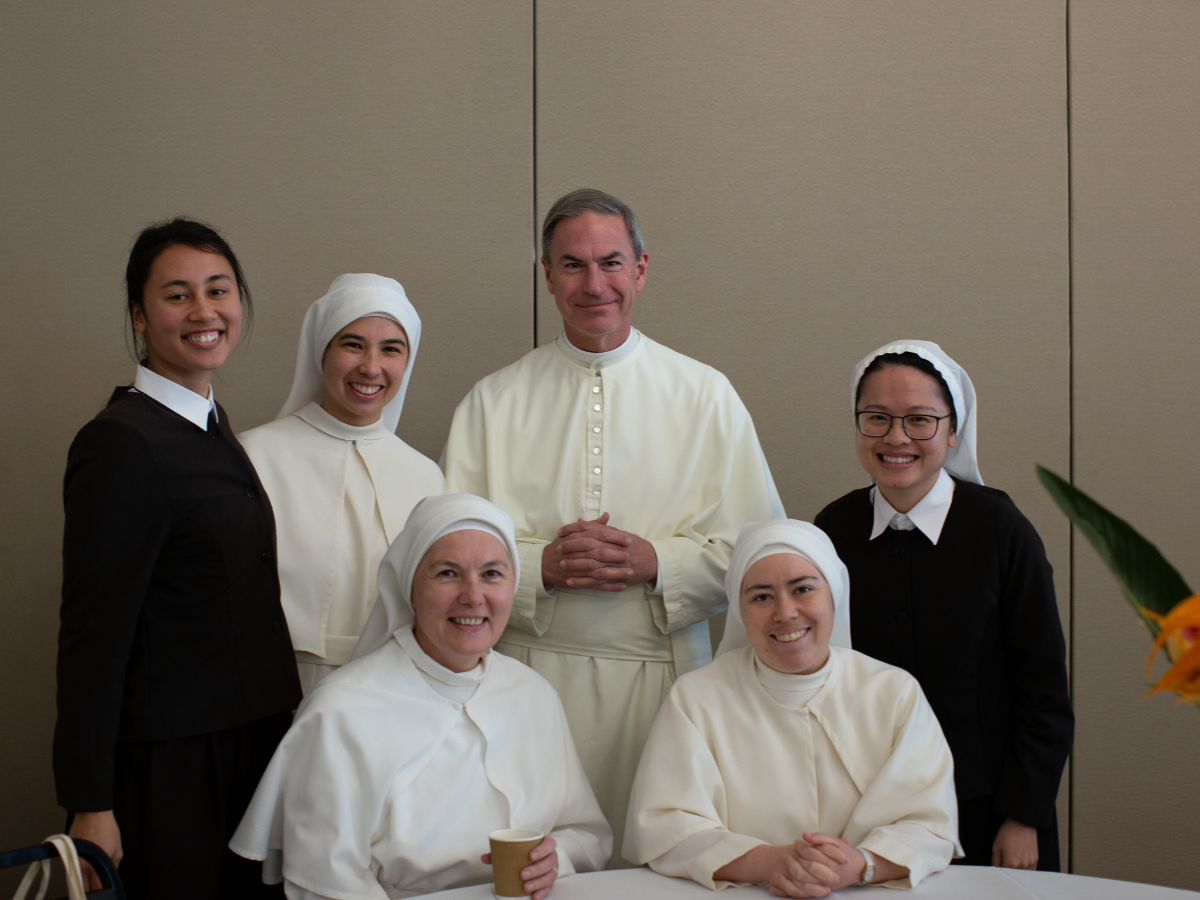In parishes throughout the Diocese of Orange, many of us are familiar with the Norbertine priests, noticeable by their all-white habits. They assist many parishes with Sunday Mass and give great homilies. Not as familiar are the Norbertine Sisters, who arrived in Orange County from their home in Wilmington a few years ago to teach in local Catholic schools.

NORBERTINE SISTERS WITH FR. AUGUSTINE PUCHNER, DURING THE WORLD DAY FOR CONSECRATED LIFE CELEBRATION AT ST. MICHAEL’S ABBEY ON FEB. 5 2022. PHOTO: MARISA TRUJILO/DIOCESE OF ORANGE
The sisters originated in the Czech Republic and Slovakia, having suffered much oppression from the time of the “Enlightenment” to Soviet occupation. For centuries the sisters were a cloistered affiliate of the Norbertine fathers, devoted to prayer. However, Austrian Emperor Joseph II, brother of Marie Antoinette, the ill-fated wife of France’s King Louis XVI, opposed contemplative orders and closed more than 500 monasteries, abbeys and convents.
Like many other persecuted orders, the sisters went underground for 150 years. In the late 1800s, the Abbot of the Norbertine Strahov Monastery in Prague encouraged restarting the active congregation of sisters. Norbertine Father Vojtech Frejka from what is now the Czech Republic took up the sister’s cause.
After 20 years from its inception, only four women had entered the convent, and in April of 1902, the sisters were vested in the traditional Norbertine white habit. This is also the date the sisters consider to be the founding of their new reconstituted order.
The sisters settled in the Slovak Republic, built a motherhouse in Vrbove and began to grow. Their daily schedule consisted of prayer, work and silence. After World War I, they opened an orphanage for disabled children. They supported themselves by making priestly vestments, teaching religion in schools, giving piano lessons, farming and caring for the sick.
But the 20th century was no less fraught with challenges for the sisters. By 1939 the congregation had grown to 153 sisters. They had opened several orphanages and homes for the elderly and schools. However, following World War II, the communist party saw the church as its enemy.
By 1950, priests were forbidden from performing priestly duties, and it was not uncommon for those who defied such orders to be put on trial. The communists sent nearly 1000 priests and other religious to concentration camps.
In August 1950, the sisters were removed from the schools they had founded with a letter from the government that stated, “You are a member of a religious community. Your beliefs don’t correspond with the communist ideology. Therefore, you cannot educate youth.”
The sisters who were nurses were allowed, for a time, to continue their work in hospitals. The rest of the sisters went to “concentration convents” where nuns from many orders lived in cramped quarters and forced to work in factories or the fields. The only apostolate they were allowed to continue was working in daycare and with handicapped children. The communists believed that their work here could not evangelize disabled children and posed no threat to the regime.
Meanwhile, as the sisters were outlawed, bullied, and persecuted, their faith and resolve remained firm. January 1968 saw a brief reprieve or “Prague Spring,” a short time where vocations began again, and communities reopened publicly. Confiscated properties were returned, religion classes resumed attracting a rapidly growing number of students.
The persecution returned with a crack-down on religious life by August that same year. The sisters were no longer allowed to wear their habits, and due to the harshness of the suppression, they had to send away 30 of their novices. The Superiors notified other congregations outside of the communist-controlled countries so that they could accept the Norbertine novices.
There is always a work-around, especially when the Holy Spirit is involved. In 1973 the sisters courageously began to accept new vocations in secret. They returned to their work but lived their religious life discreetly.
After the fall of the Soviet Union in 1989, religious life once again began to flourish. The confiscated property was returned, and sisters living their vocation underground were now able to wear their habit and return to their communities.
In 2011 Sr. Adriana Gacikova and Sr. Benedikta Hornikova were invited by the Norbertine fathers to establish a convent in Wilmington, California, and serve at Sts. Peter and Paul Parish to teach religion and Latin.
In 2019 the sisters came to teach at St. John the Baptist parish in Costa Mesa. Today, there are six intrepid sisters in Orange County serving in parishes and schools.
It has been a nearly 150-year journey from Prague to Costa Mesa for these sisters. They are strong, resilient and dedicated servants of God who bless the community by their faith. If you see Sr. Adriana or one of her five sisters, ask about the epic Norbertine Sister’s “family” story. It is one of incredible resilience and proof of the power of the Holy Spirit.


